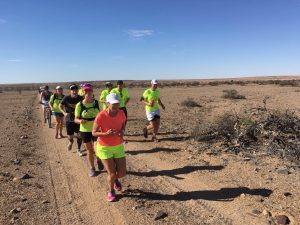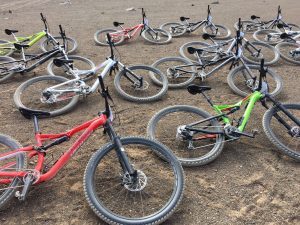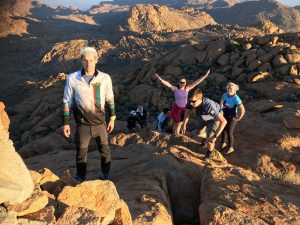IN NAM DESERT CHALLENGE
The IN NAM Desert Challenge will pit our graduates against their own limits, and the harsh desert, in 6 days of tough physical challenge. As last year’s team proved, completing all elements is entirely possible, and immensely rewarding- but requires willpower, resilience and months of committed preparation.
There are three key elements to the Namibian challenge, which the INEOS team will be guiding the team to tackle:
- Endurance running (half marathon and marathon distance runs through the desert heat and sand)
- Technical mountain biking (distances of 80+km at once through technically challenging conditions- corrugated tracks, sand, dried river beds and rocky descents)
- Mountain climbing/scrambling (with 15-20kg backpacks)
All three disciplines can be mastered with adequate training in advance- and the IN NAM Challenge team will provide our graduate team with 1:1 and group coaching, training plans, formal training events and nutritional and injury prevention advice. Please also head to the Energy Station website for fitness tips and training plans.
ENDURANCE RUNNING
Endurance running is, arguably, the simplest part of the trip to train for- since the kit required is minimal, opportunities to take part in public races are plenty, and running builds strong base fitness for all other elements of the trip.
Whether you are already a committed/accomplished runner, or are a complete novice building up to 5k, you’ll be able to take on Namibia with the right preparation. The key is to start early, and build up slowly. You can find a range of running training plans for all abilities here. Please note- in order to avoid injury, it is not recommended to increase your running distance by more than 10% each week. For further injury prevention tips, please see here.
INEOS will assist with your running training by providing expert advice and the opportunity to complete a local marathon with the graduate team.
Getting started
New to running? No problem. You can go from couch to marathon distance in 16 weeks with dedicated training. Start by getting a good pair of shoes (it’s worth getting your gait analysed in a sports shop), put them on and get out there! Build up to running for 30 minutes by mixing up walking and running at first- and once you’re happy with this you can gradually increase the time and distance you cover. Good music and good company help!

TECHNICAL MOUNTAIN BIKING
In terms of distance covered, the mountain biking element of the Namibian challenge is the largest chunk of the trip. Mountain biking requires a distinctly different skill set to road biking, and the best way to prepare for this element is some formal training, combined with plenty of hours in the saddle! Cycle training will build your fitness in a different and complementary way to running- and combining both types of training will help you to avoid injury.
Core skills required for the cycling element of the trip include use of SPD cleats, proficiency on a range of terrains, and technical descents and ascents. INEOS will provide an initial training course to build these skills and will require the graduates to report on their MTB progress as their training progresses.
Mountain bike recommendations:
- Between £500 and £1500
- Suggested suppliers and models:
- Cube Hard Tail bikes (full suspension are more expensive)
- Specialized Trail bikes
- Giant Hard Tail bikes
Getting started
New to mountain biking, or even cycling? No problem. You can start building up your cycle fitness now by attending spinning classes- and it would be well worth getting a bike for commuting/riding at weekends. Before you try and learn MTB-specific skills it’s worth building up time in the saddle, so that you are comfortable with riding longer distances. It is also worth working on your core and upper body strength in the gym.

MOUNTAIN CLIMBING
In the middle of the Namibian challenge week the team will be taking on the country’s highest mountain, the Brandberg. At 2606 metres, this is no small feat, especially since the team need to carry their own camping gear, food and water to the top in a backpack weighing approx 15kg.
The best way to prepare for this challenge is to practice similar ascents, with weighted baggage- it is key to build strength in your knees both for going up, and coming down. Whether you live near a similar mountain, or only have access to the office stairs, there are plenty of creative ways to build this element of your training, both on your own and with the team.
Getting started
Never climbed a mountain? No problem. You can begin to train for this element by strengthening your knees and legs- even just by climbing stairs. Ditch the lift, practice climbing and descending flights with weighted backpacks, bring fellow grads into a climbing challenge… And if you live near any hills, then get out climbing! It’s well worth building your leg strength in the gym through weights and circuits class too.
